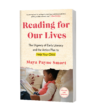Whether you and your family root for your college team or love to watch your favorite NFL players, you’ll all be a fan of these football picture books! These sweet reads capture the magic of a fall day in the stadium: the excitement in the stands, the heartbreaking losses, the underdog victories, the athletic feats, and the inspiring stories of the players themselves.
Aspiring football players and all sports fans—kids and adults alike—will enjoy learning about legendary players and the importance of teamwork, perseverance, and chasing your dreams. Kick off story time with these 10 inspiring reads, and then let us know your favorite titles.
To learn more about Ernie Barnes, try Between the Lines: How Ernie Barnes Went from the Football Field to the Art Gallery, an award-winning picture book by Sandra Neil Wallace.
For fans of By My Brother’s Side, explore seven other books by the Barber brothers, including Kickoff!, Go Long!, and Red Zone.
Read more: If the little fans in your life enjoy these football picture books, try reading our other lists of sports books, too.
What are your favorite sports reads for kids?
During an elementary school supply drop-off visit at my daughter’s school one day, I was struck by how much preparation must have gone into coordinating 60 minutes of activity for the hundreds of students and families in attendance. As we approached the front entrance, the principal and staff members welcomed us, ushered us toward classrooms, and answered our questions. Once inside, vibrantly decorated chalkboards, doors, and walls greeted us. And we thoroughly enjoyed the chance to organize her desk and locker, easing pleasantly into the start of the new year.
We were spared all of the meetings, emails, checklists, and minutiae that go into pulling off events like this. We didn’t even have to labor over our part of the equation, gathering the school supplies themselves. We didn’t trudge through the aisles of stores picking out notebooks, crayons, and pencils like when I was a kid. No, we ordered the whole bundle in one fell click via a link the school had emailed us.
Thinking of all the work the staff and teachers put into making things easier for us got me pondering what families should be doing to make things easier for teachers. What are our obligations as partners with teachers in our children’s education? What contributions can we make to kids’ school success through the habits we instill, activities we plan, or attitudes we cultivate at home? Where does teachers’ work end and parents’ work begin? Or, more accurately, how should we connect, collaborate, and communicate to reinforce, amplify, and support one another’s work for the kids’ benefit?
There are so many things we as parents can do at home and before kids start kindergarten to get them ready for school, from preparing them for what to expect and how to act at school to dressing them for success (it’s not quite what you think). But once they’re through the gates, our part is far from done. Here are a few touchstones for what parents should do once kids are in school:
Know the Expectations
A critical factor in having a good school year is defining a good school year. Yet too few parents have a clear understanding of the academic expectations of their children’s teachers, schools, districts, or states. Instead, all too often we look to lagging indicators like grades on individual assignments, report cards, or standardized test results to tell us how our child is doing. A better approach is to look ahead and learn what our kids are expected to know or be able to do by year’s end—as well as how their teacher plans to get them there.
This eye-opening exercise can give you a sense of the breadth and complexity of what students are expected to learn. It can alert you to opportunities to cultivate developmentally appropriate knowledge and skills at home. It can also highlight areas of weakness that may warrant extra help beyond school or home, for example through tutoring, field trips, or enrichment programs.
When my daughter was younger, I paid particular attention to the foundational reading standards because I knew those skills pave the way for all later subject-matter learning. Once she was a fluent reader, I locked in on the grade-level writing standards. These include capacities that will serve her well lifelong, such as how to:
- Write arguments to support claims with clear reasons and relevant evidence, using credible sources and demonstrating an understanding of the topic or text.
- Write informative/explanatory texts to examine a topic and convey ideas, concepts, and information through the selection, organization, and analysis of relevant content.
- Write narratives to develop real or imagined experiences or events using effective technique, relevant descriptive details, and well-structured event sequences.
- With some guidance and support from peers and adults, develop and strengthen writing as needed by planning, revising, editing, rewriting, or trying a new approach.
- Use technology, including the Internet, to produce and publish writing as well as to interact and collaborate with others; demonstrate sufficient command of keyboarding skills to type a minimum of three pages in a single sitting.
- Gather relevant information from multiple print and digital sources; assess the credibility of each source; and quote or paraphrase the data and conclusions of others while avoiding plagiarism and providing basic bibliographic information for sources.
Basically, she should be fully capable of writing a blog of her own. Here’s how you can find out what your child needs to learn this year: Check out the Common Core State Standards to see what 41 states, the District of Columbia, four territories, and the Department of Defense Education Activity agree kids should be able to know and do at each grade level. For states like Alaska, Texas, Indiana, Florida, and Virginia that have their own standards, Google the state name followed by “learning standards” or “curriculum standards” to find details.
Read School Communications
We’re all suffering from information overload, but one great way to build goodwill with your child’s teacher from day one is to actually read the information that comes home in a timely fashion. And then do your best to respond warmly, enthusiastically, and quickly, as you would expect your child to. The teacher’s job of educating your child and their classmates is already taxing. Don’t add the extra burden of educating you on information they’ve previously shared.
It may not be ideal for you to have to sift through a child’s backpack for a paper flier, read each item in classroom e-newsletters, or log into the school website for the field trip calendar, but it’s best to do it anyway. As Vlada Lotkina, CEO of parent-teacher communication platform Classtag, observes, teachers’ day-to-day reality is challenging, too. “Not only do teachers face conflicting parent expectations and preferences for when, what, and how to communicate, but they also have to manage this and a multitude of admin tasks on top of their core teaching responsibilities,” she says.
In short, answering needless inquiries from parents takes away from the time they can devote to teaching our kids. So before you dash off the email asking how your child will find the right classroom when they get off the school bus, see the note that came home explaining that the teacher will be greeting kids in the play yard, starting at 7:35, with a sign with her name on it.
Also make a special note of what method of communication each teacher prefers. It’s easier and more effective for you to adapt to their style than to get them to switch to yours. Remember, every teacher deals with dozens of parents. It’s unreasonable to ask for elaborately tailored communications, e.g. to text you, but email your wife, and chat in person with the babysitter at pick-up. Be flexible and read the information that comes your way, however and whenever it arrives.
And if you feel so moved, advocate for communication solutions that leverage technology to reach parents through their preferred methods, so that the personalization doesn’t fall on the teachers’ shoulders.
Put the Home in Homework
There’s a great deal of debate circulating about the merits of homework, particularly with younger children. Does it actually help them master the intended material? Does it steal time from family meals, bonding, and other learning and enrichment activities? Does it create stress and anxiety for parent and child? The answer of course is: It depends. It depends on the nature and amount of the assignments; the intentions and effectiveness of the teacher; the maturity, skills, and disposition of the child; what else the family has going on; and innumerable other factors.
So, in my mind, as a parent, the most pertinent question isn’t whether homework in general is good or bad, but how our family in particular is going to approach whatever homework our child receives. In this way of thinking, parents need to know:
- What kind of homework will be assigned and how frequently? E.g., will there be daily assignments and/or longer-term special projects?
- How long is the child expected to spend doing homework?
- What kind of parent participation in homework does the teacher expect? E.g., should parents be reading along, going over instructions, answering questions, checking results, signing off on it?
Sometimes you may have to ask the teacher about these things in an email or at back-to-school night. Often you won’t. Veteran and proactive teachers tend to provide this kind of info upfront. We’ve just got to notice and digest it.
My daughter’s third-grade teacher sent weekly emails offering insight into the work ahead and what appropriate parent support would look like. One memorable dispatch arrived with “Rigor, Time Management & Expectations” in the subject line. Inside, she broke down her intention to provide learning experiences that were academically, intellectually, and personally challenging to students; why such rigor was different for each student; and how students’ ability to prioritize tasks, plan ahead, and complete assignments on time was another matter altogether. She made it clear that our role was to check in and ask our kids questions about their research reports and other assignments, but not to take over or do intensive teaching. She’d provided ample instruction, examples, rubrics, and so on during class time.
Other times, you will need to ask your child’s teacher for more information, either on their overall approach or on specific subsections of the curriculum or assignments. Request the details you need to help your child succeed. For example, see our post on asking teachers about spelling instruction: Nine Questions to Ask Your Child’s Teacher About Spelling.
For example, when my daughter was heading into a new classroom with a new teacher at a new school in a new state, I had a lot to learn about the workload, grading policies, and parent expectations there. But I was already clear on my primary parent duties. These are things every parent should be striving to achieve, within your particular constraints and abilities:
- Provide a quiet, well-lit, well-stocked, distraction-free space to do the work.
- Ask questions that help the child prioritize and plan how they’re going to get their work done.
- Support them in keeping the commitments they make to themselves around when and how they’ll work.
- Use specific language to praise the work ethic, organization, and tenacity they show in completing assignments, to reward their effort and encourage more of it.
Supplement with Intention
An email from a one-on-one tutoring company landed in my inbox with the subject line, “A Successful School Year for Your Student.”
“Now more than ever, your child deserves an effective, reliable learning experience,” the message inside read. “We can help.” To illustrate the point, it featured pictures of three children of diverse ages and ethnicities happily engaged in learning activities—a teen reading a thick hardback book, a young girl smiling and gazing off as if visualizing the spelling of a word, and a little boy seemingly deep in thought with a blue pencil hovering above his composition book. The takeaway was clear: One way parents can help kids “read and comprehend to their potential” is to hire a tutor.
Should parents have to pay to secure basic literacy skills for their kids? No. Do they? Often, yes. The reality is that private tutoring is a major player in the reading landscape, with implications for how, when, and whether kids fulfill their reading potential. I looked up statistics on tutoring nationally and internationally, and found a major uptick in tutoring for early-elementary students. Before the COVID-19 pandemic hit, the sector was nearing $800 million in annual revenue. Large franchises like Kumon experienced rising enrollment among preschoolers, according to market research firm IBISWorld. Some of this demand is driven by parents bent on creating super-achieving students, but much of it comes from a simple desire to get a struggling child to “grade level.”
I wish it weren’t the case, but the booming supplemental education industry props up reading achievement on a national scale. Getting a sense of your child’s prospects for the year—what’s expected of them, where they stand, and how successfully their school and teacher may move them along—could lead you to call in some reinforcements. If that’s the case, know that you’re far from alone.
But supplementation isn’t always about bringing in the big guns. Often parents can make an impact by bringing real-world context and experiences to school subjects. Wisconsin history is a focal point of the fourth grade curriculum in our state, so we took a little trip to Madison before school started that year. We visited the capitol and began accumulating the little points of reference and insights that my daughter could build on when her class dove into the topic later that year. As she gets older, I continue to keep an eye out for fun ways to connect while building on what she’s learning at school.
Like this post? Please share it!
Did you ever wonder why storybooks for kids are filled with illustrations or visuals? It’s because it’s proven that using illustrations alongside text helps in increasing children’s learning retention. According to Dr. Haig Kouyoumdjian, “Words are abstract and rather difficult for the brain to retain, whereas visuals are concrete and, as such, more easily remembered.” This is the power of visual imagery in learning.
There are a lot of fun ways to encourage young kids to enjoy engaging with books and print. One way is combining words and pictures together. Just like storybooks! We know that a lot of busy parents are looking for free and easy resources online to use in teaching their kids—especially those who are just starting out in reading. That’s why we love to create printables for use at home that will help kids enjoy learning as much as we do.
As Halloween is fast approaching, we created a free Halloween printable for busy and creative parents. It’s a word spinner that consists of Halloween-related words and illustrations from A to Z. It is a very easy DIY project that your kids can help you out with. All you need is a home printer and some simple materials that you likely have at home.
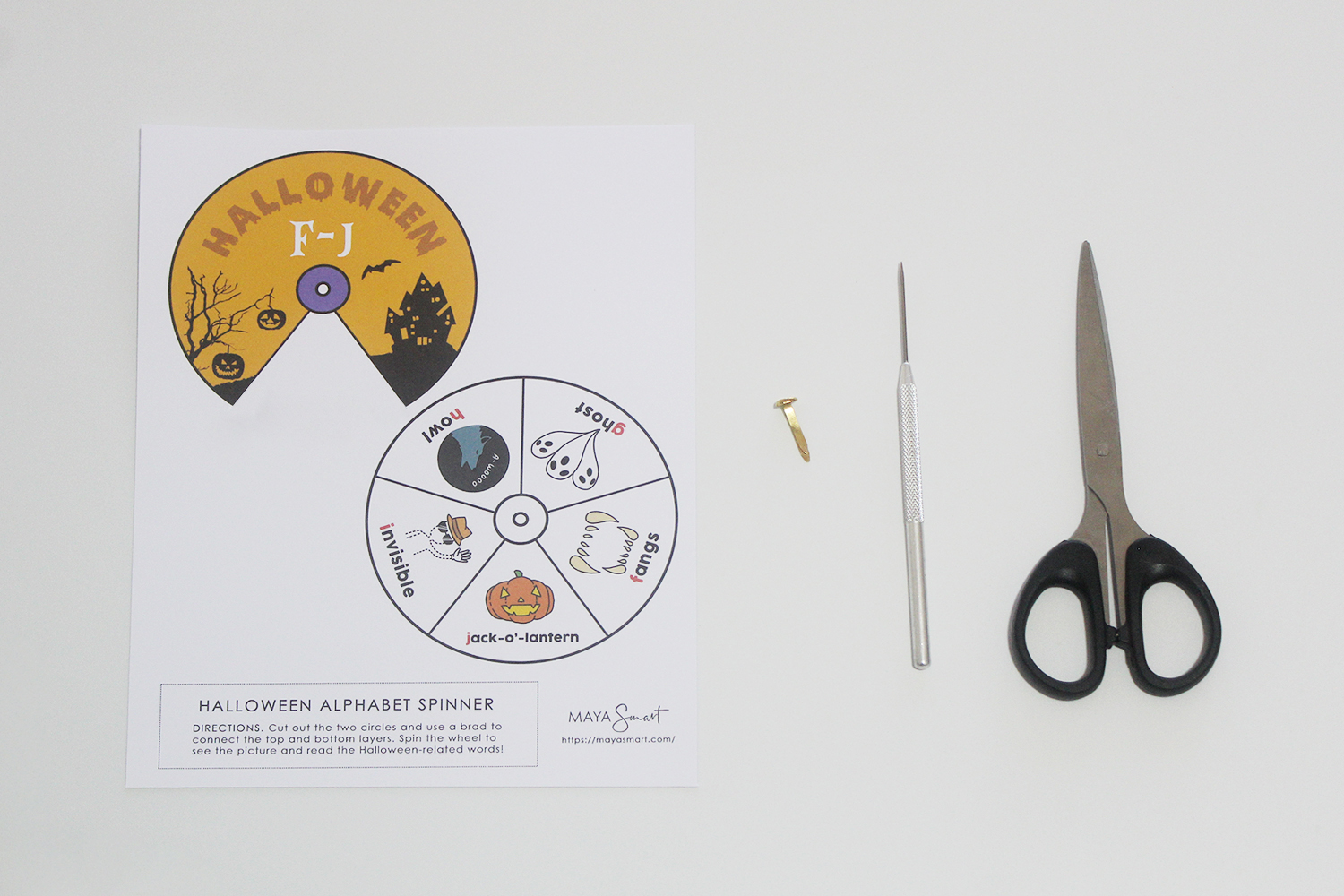
Materials:
- Printer
- Cardstock — 5 pieces (to print free Halloween alphabet spinner template)
- Scissors
- Paper piercer (or any sharp object)
- Brad pin
Cost: $3 or so for a whole pack of brad pins
Step 1: Print out the free Halloween alphabet spinner template. This is best printed on cardstock paper instead of regular paper, so that it will not be flimsy when you spin it.
The printable consists of five pages dividing the 26 letters of the alphabet into five sets: A–E, F–J, K–O, P–T, and U–Z. You can make all the Halloween alphabet spinners at once, or space them out as you see fit to keep the learning activity fresh and fun for your child.
Tip: If you begin with just one, choose the printable that includes the first letter of your child’s name. Teaching children letter names and sounds beginning with their own first initial is a good way to engage them and keep their attention.
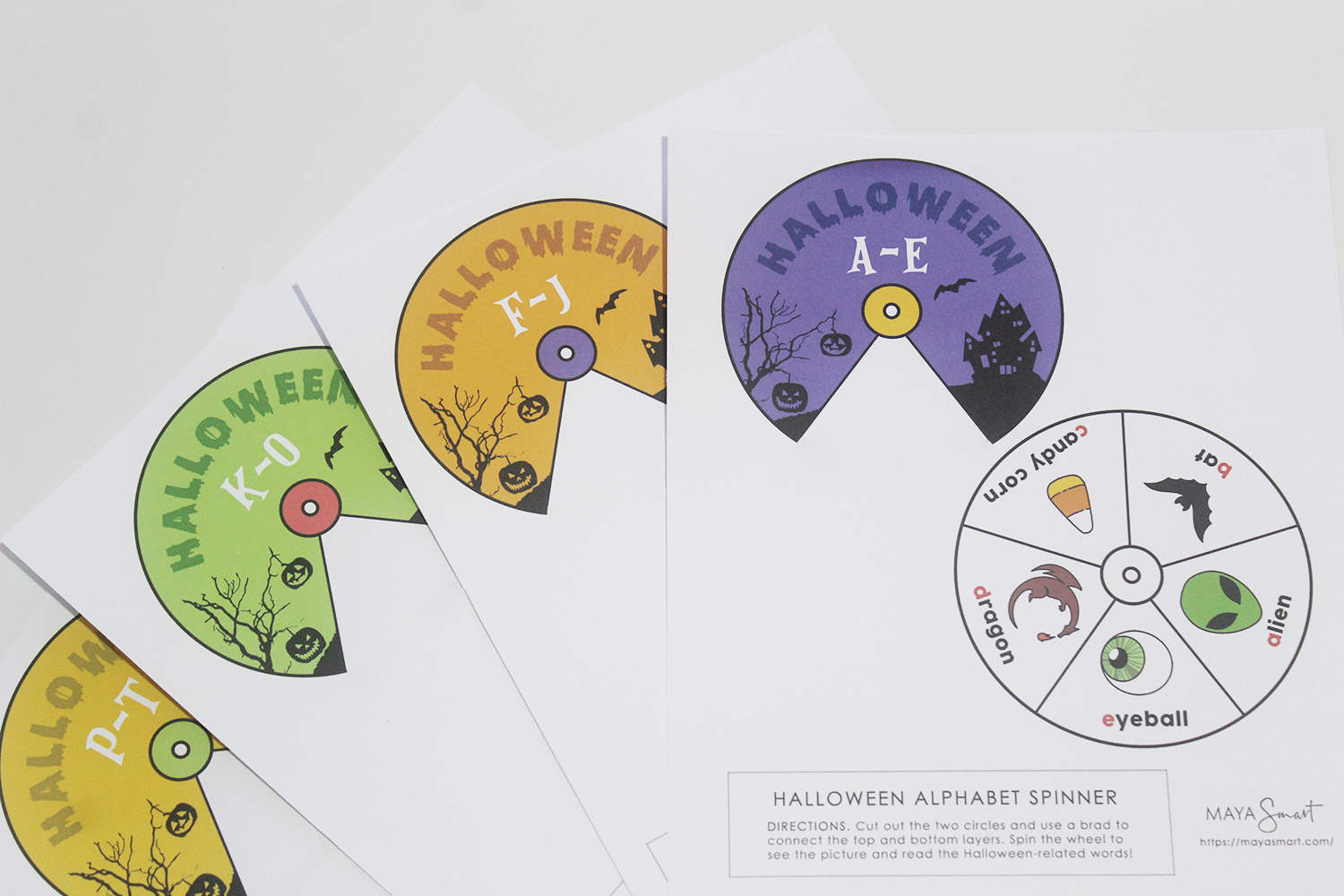
Step 2: Next, you need to cut out the two circles from the printable. The top cover is not a perfect circle, but looks like a Pac-Man shape.
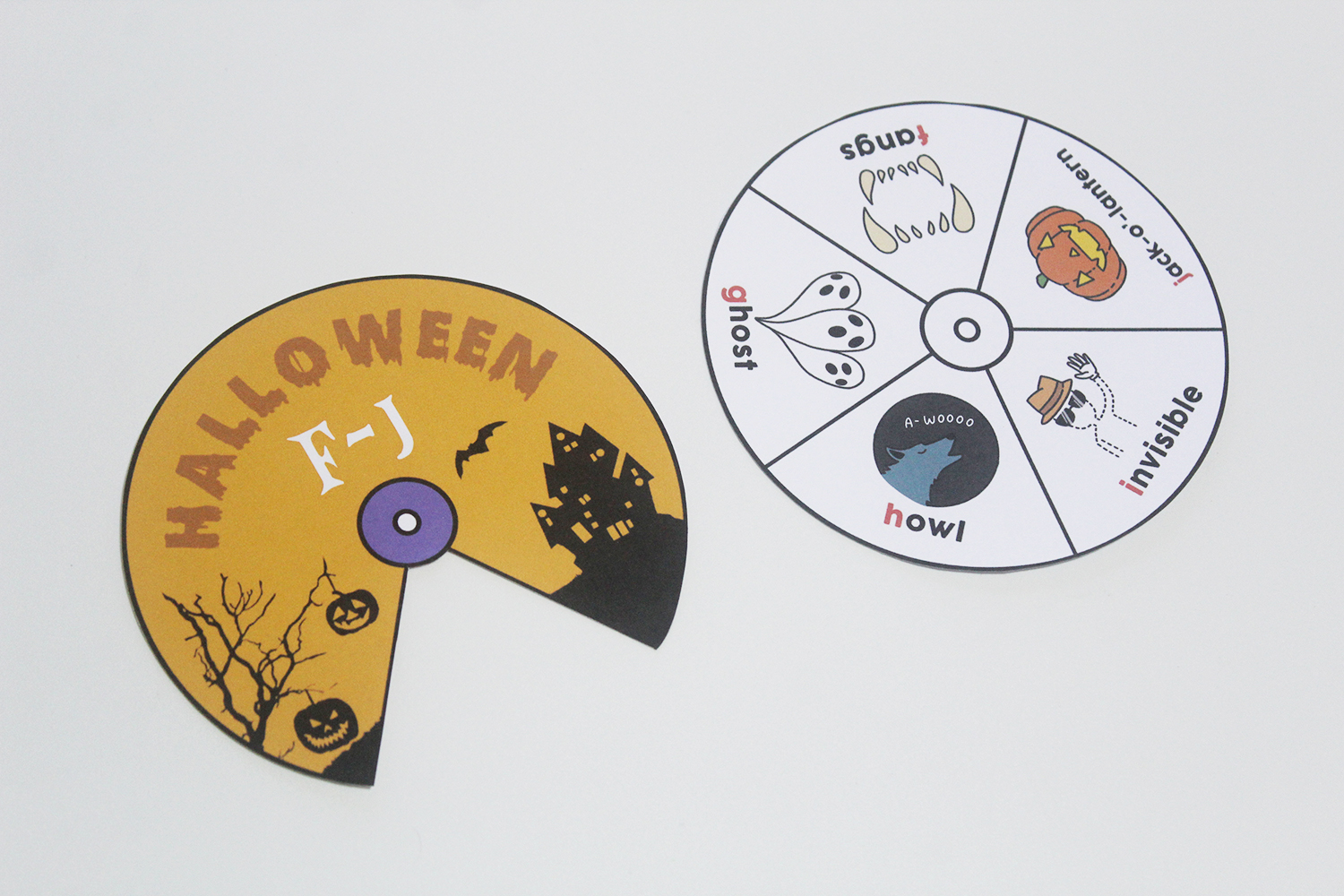
Step 3: When you are done cutting, it’s time to poke holes in the center part of both circles using a paper piercer or any sharp object. This will help you in inserting the brad smoothly and avoid scrunching the paper. If your child is helping you out with this project, make sure that he/she is supervised when using any sharp objects.
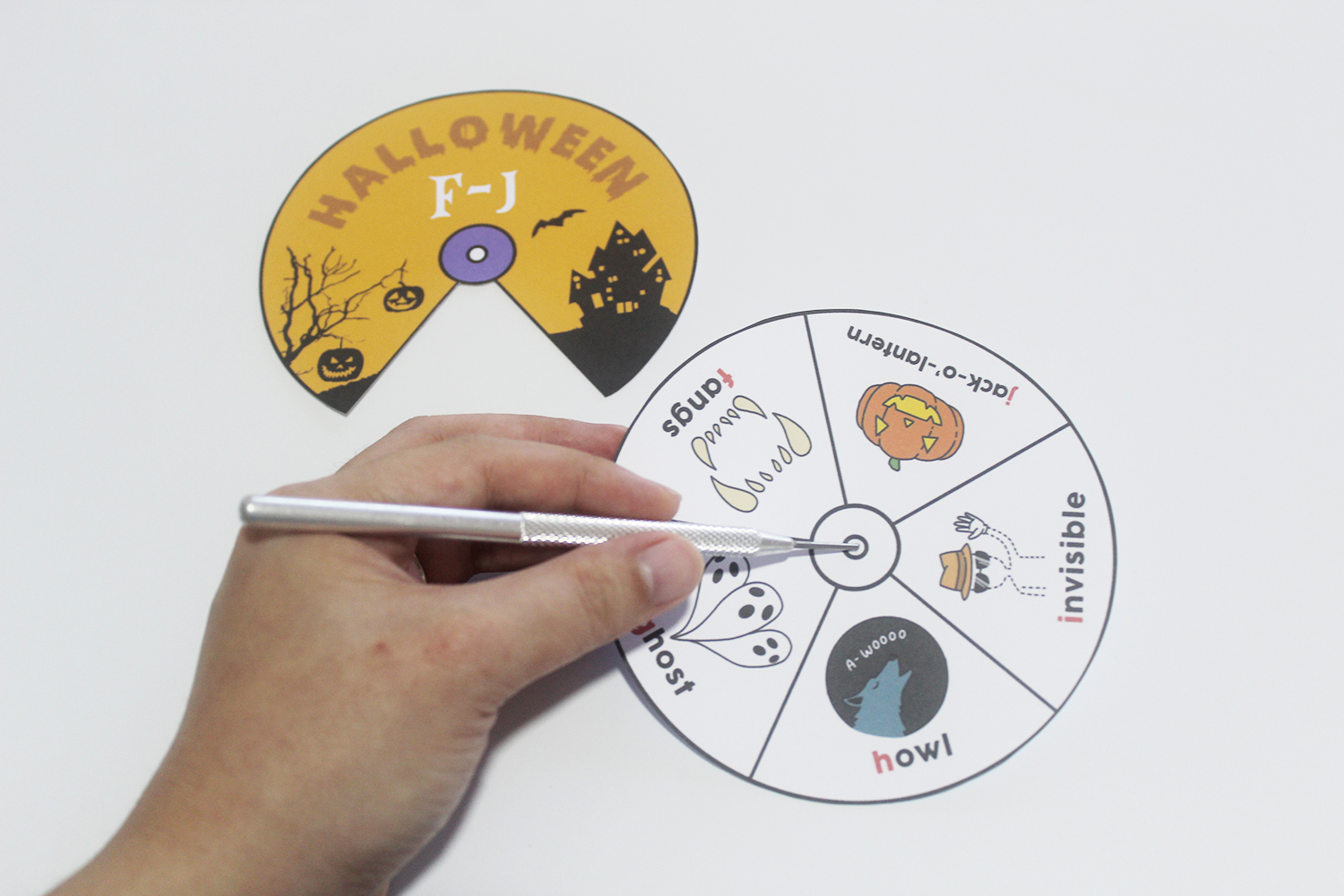
Step 4: Now it’s time to assemble the spinner! Place the cover on top of the bottom layer and insert the brad pin through the holes.
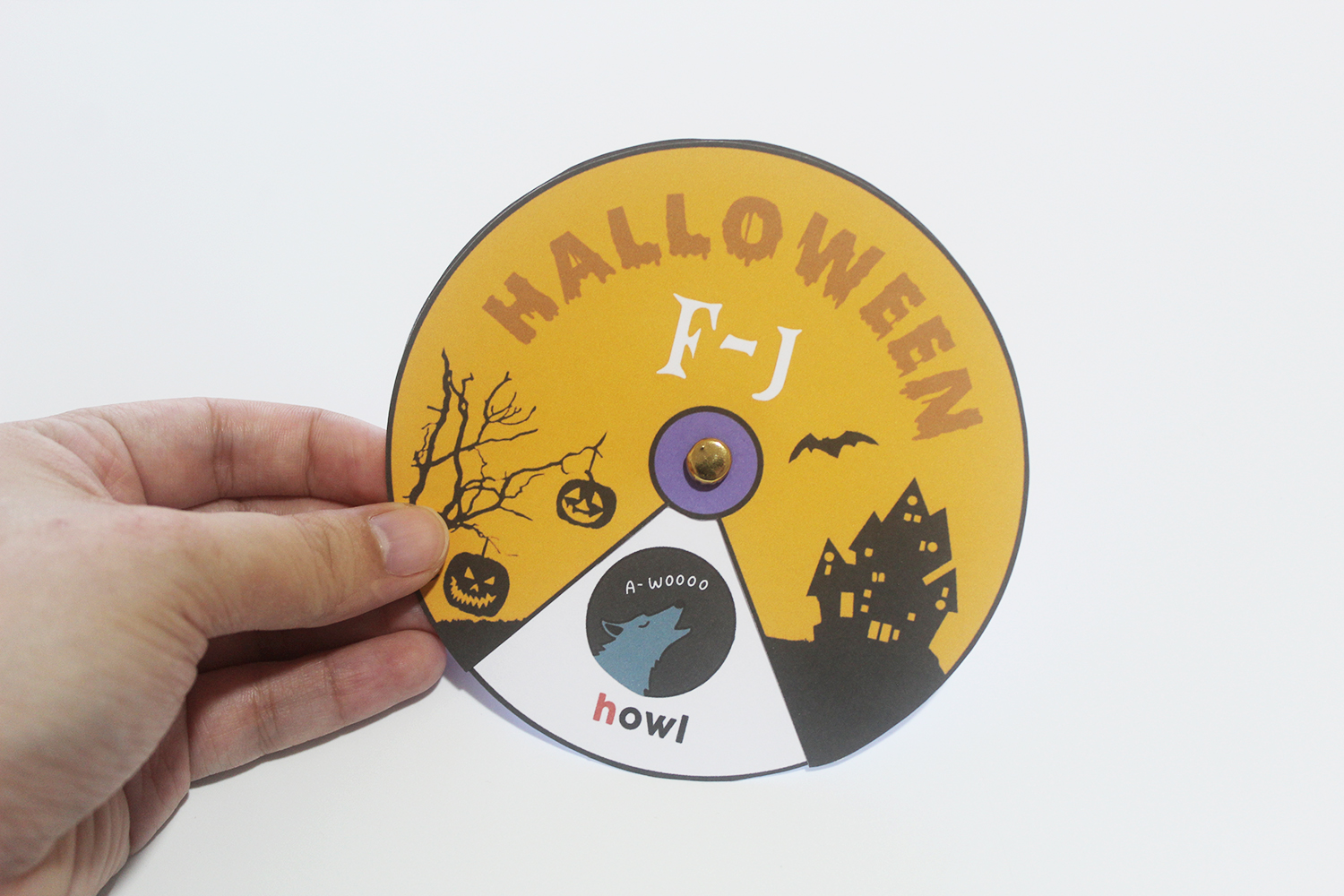
Step 5: Separate and bend the prongs at the back to hold both circles together. Try spinning the cover wheel to see if the brad works well and smoothly.
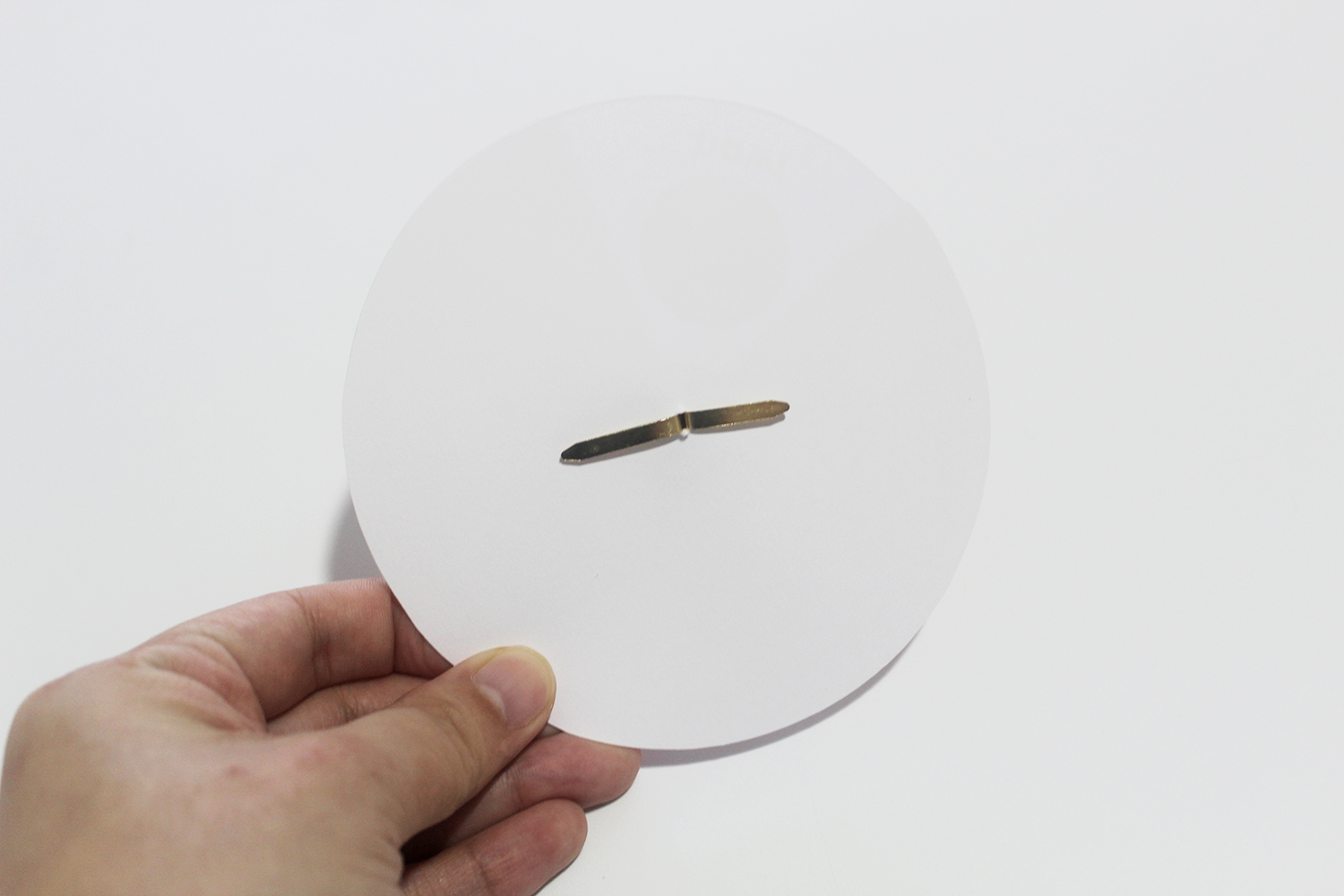
Step 6: Create all five templates to have a complete set of Halloween-related words from A-Z! Spin the wheel to uncover different Halloween-related words and photos.
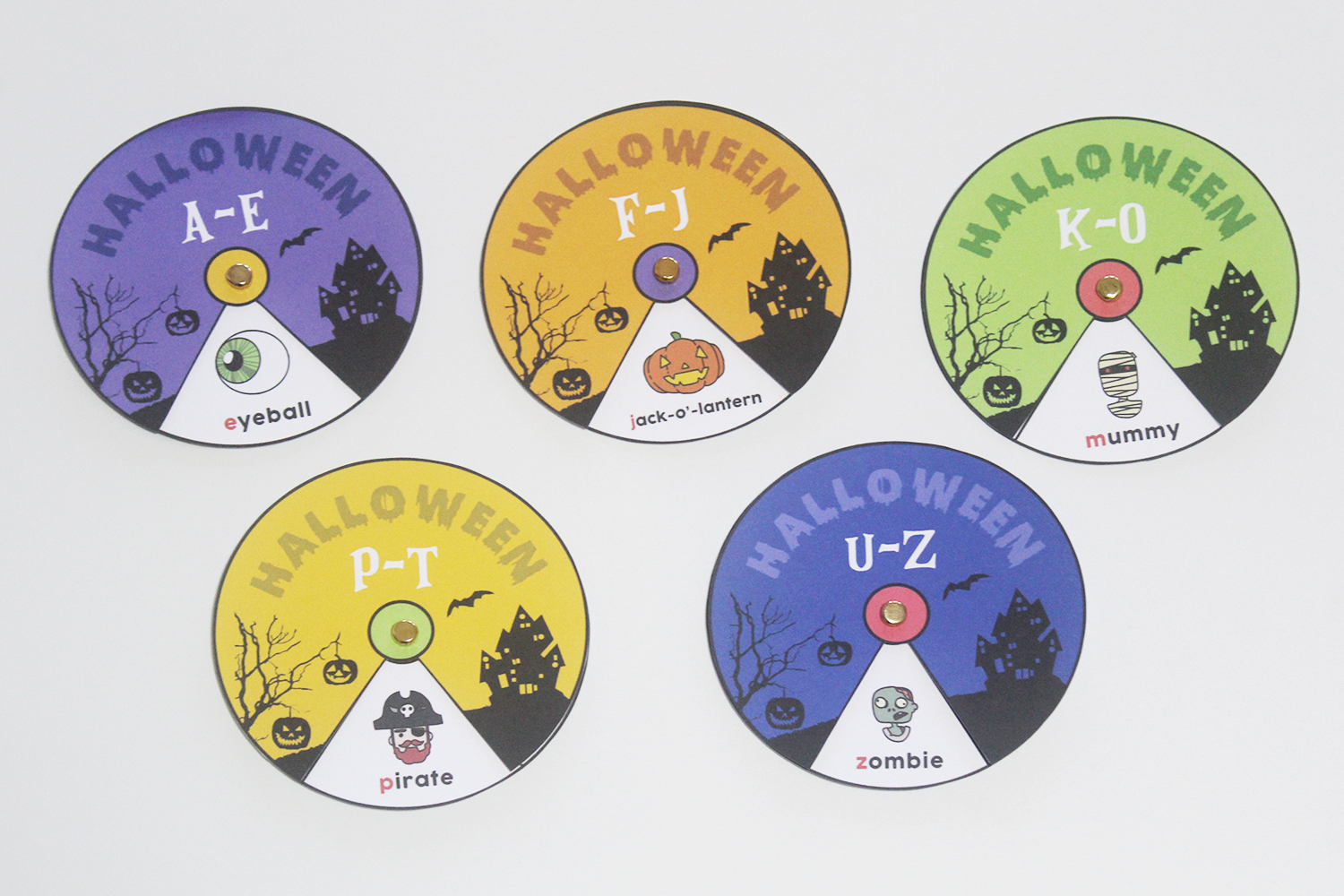
And you’re done! I hope this free Halloween printable alphabet spinner will help you create a fun learning experience with your child this Halloween season.
When you use it, highlight to your child the starting letter of each word, and help them match the initial sound to the letter. For slightly older kids, you can invite them to try to guess what some of the words will be in each letter group before spinning the cover to reveal the answers.
By Laila Weir
Raising little readers and writers means providing plenty of reading and writing material, which in turn can mean a whole lot of pencils, pens, and markers trailing around your home (or your kid’s backpack).
Get organized with these cute DIY pencil cases that your child can make in just a few easy steps from common household items. These crafts offer an eco-friendly and fun way for kids to bring their own flair to personalized holders for use at home or on the go. Rather than buying new, you’ll reduce your impact on the environment and create your own unique pencil case.
In our super-simple tutorials, you’ll learn to upcycle a plastic container and a plastic bag into adorable containers for your child’s writing implements. Both pencil cases close, so you can toss them into bags for school or outings, but they make cute organizers for craft tables or homework corners around the house, too.
After you check out the tutorials below, scroll down to learn how to make a DIY pencil pinwheel. Kids will love using these special pencils, which are sure to jazz up writing time!
DIY Recycled Pencil Holder
With just a little glam, you can upcycle a plastic container into the perfect storage container for pencils, markers, and even crayons! There are so many different plastic containers for food that are the perfect size to repurpose into a pencil holder. We used a roasted peanut jar, but many different items that would have been headed for the recycling bin will work. This is a fun, easy, and environmentally responsible project to do with your kids. (Tip: If you want your container to close, remember you’ll need one that’s long enough to hold your pencils. Or use a shorter container to make an open-topped holder for a desk or craft table.)
DIY Easy Duct-Tape Pencil Case
In this brilliantly simple craft, you simply cover a large ziplock bag with duct tape to create a customized pencil case. (You will want to read our tutorial, though, for tips and tricks to make sure your project goes smoothly!) Use duct tape in a fun pattern to create a super-cute case, layer different colors to create your own pattern, or just use a single color to make a quick and easy pencil bag. You can even punch three holes along the bottom of your case and it will fit perfectly in a binder. The duct tape reinforces your bag, so this can be a good way to give new life to a still-usable plastic bag that’s been used to hold other items.
Bonus: DIY Pencil Pinwheels
It’s a pencil! It’s a toy! These handmade pencil pinwheels will make writing so much fun. They make a cute back-to-school gift for children or teachers, and they’re sure to add a playful touch to literacy activities with kids of all ages at home, too. Just note that this craft involves using a straight pin, so consider supervising safety when kids put their pencil pinwheel to use.
If you and your little one love these crafts, check out our decoupage notebook tutorial to add a personalized notebook to your collection of customized literacy supplies, too.
How else are you sprucing up your child’s writing corner? We’d love to hear your ideas!
By Laila Weir
Little kids love crafts, and they love dressing up. That’s probably why making beaded jewelry is so popular with the preschool and kindergarten sets. It also builds important fine motor skills, but guess what–with a simple adaptation, you can also use this fun activity to teach early reading and spelling.
The seeds to literacy are planted long before kids start school, so it’s crucial for parents to introduce key knowledge to kids early on. And the best way to do it is to weave learning into everyday activities and fun with your kids. In that spirit, this simple game leverages the fun of beading to teach children early reading and spelling, helping turn practice into play.
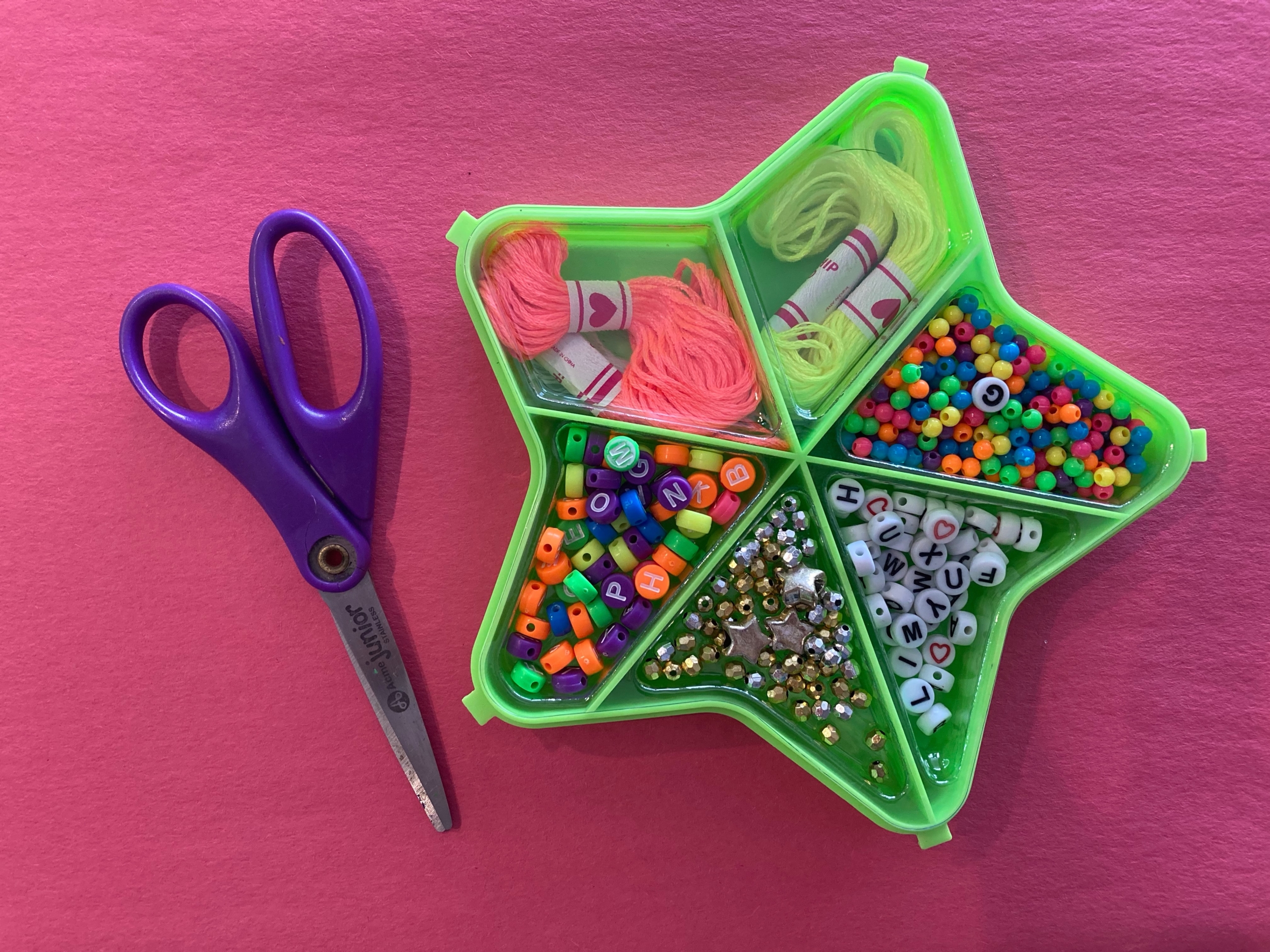
Materials:
- Alphabet beads (plus other beads if desired)
- String
- Scissors
Cost: Under $10
Step 1: Write out a list of words you want to practice spelling and reading with your child. Then identify which letters you’ll need to form those words. Ideally, you’ll want to think of several words that can be spelled with the same letters.
For a simple start, plan on CVC words — consonant, vowel, consonant — which are easy to sound out. For example, you could make the words top, mop, cat, hat, mat, pat, pot, sat, and sap using the letters T, P, M, C, H, S, O, and A. As your child advances in skill, you can use these same letters to make words with consonant blends, like stop, past, shop, post, etc.
Step 2: Cut the same number of pieces of string as the number of letters you’ll be using. For the example above, cut eight pieces. Make the pieces long enough to fit around your child’s finger, leaving plenty of excess to tie them securely. (Note: If you want to spell words that need to repeat letters, you should make two of the letters that repeat.)
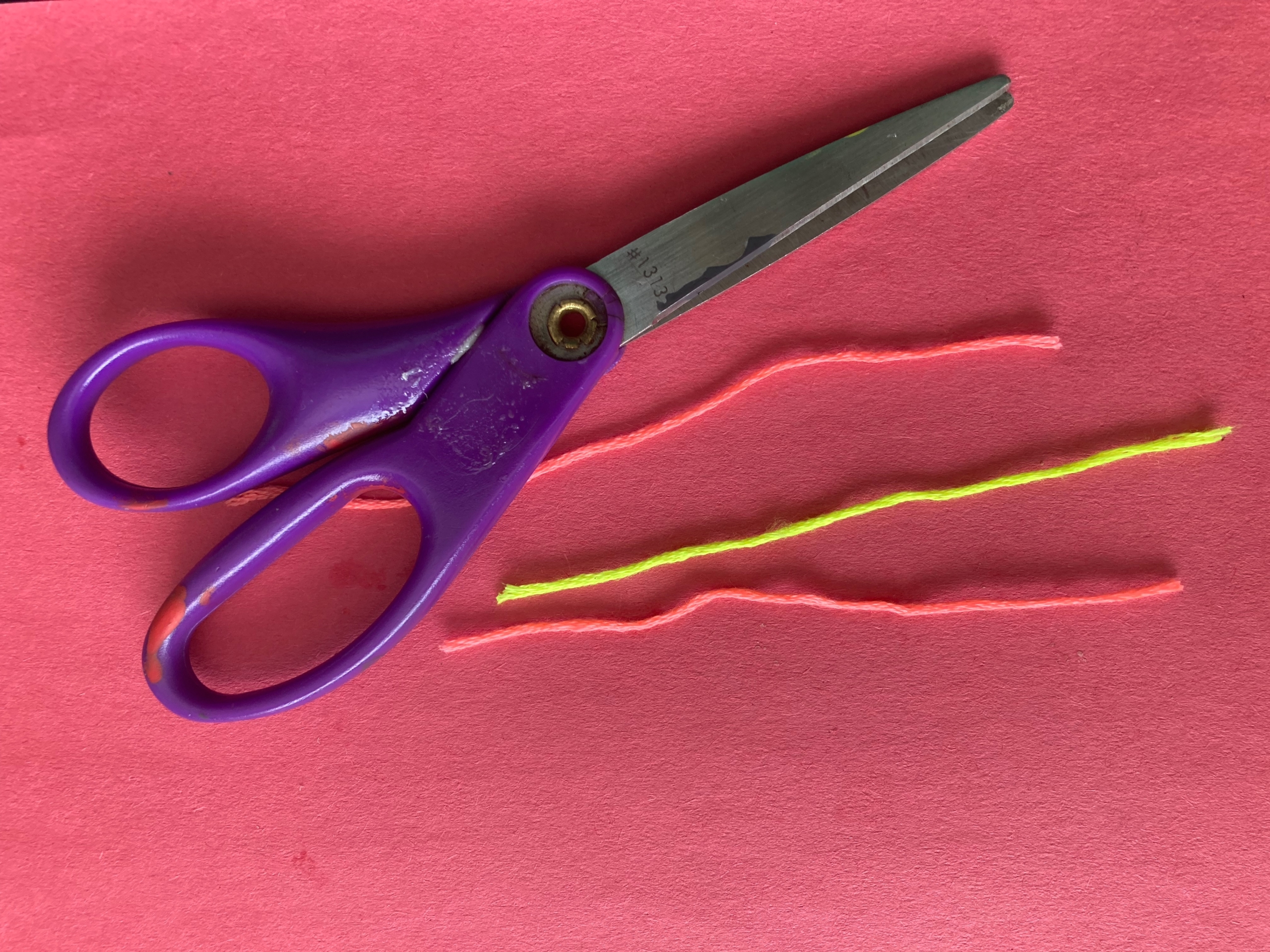
Step 3: Help your child put one of your target letters on each piece of string. You and your child can add other beads in any pattern you like to beautify your creations. Then tie the pieces together to make rings.
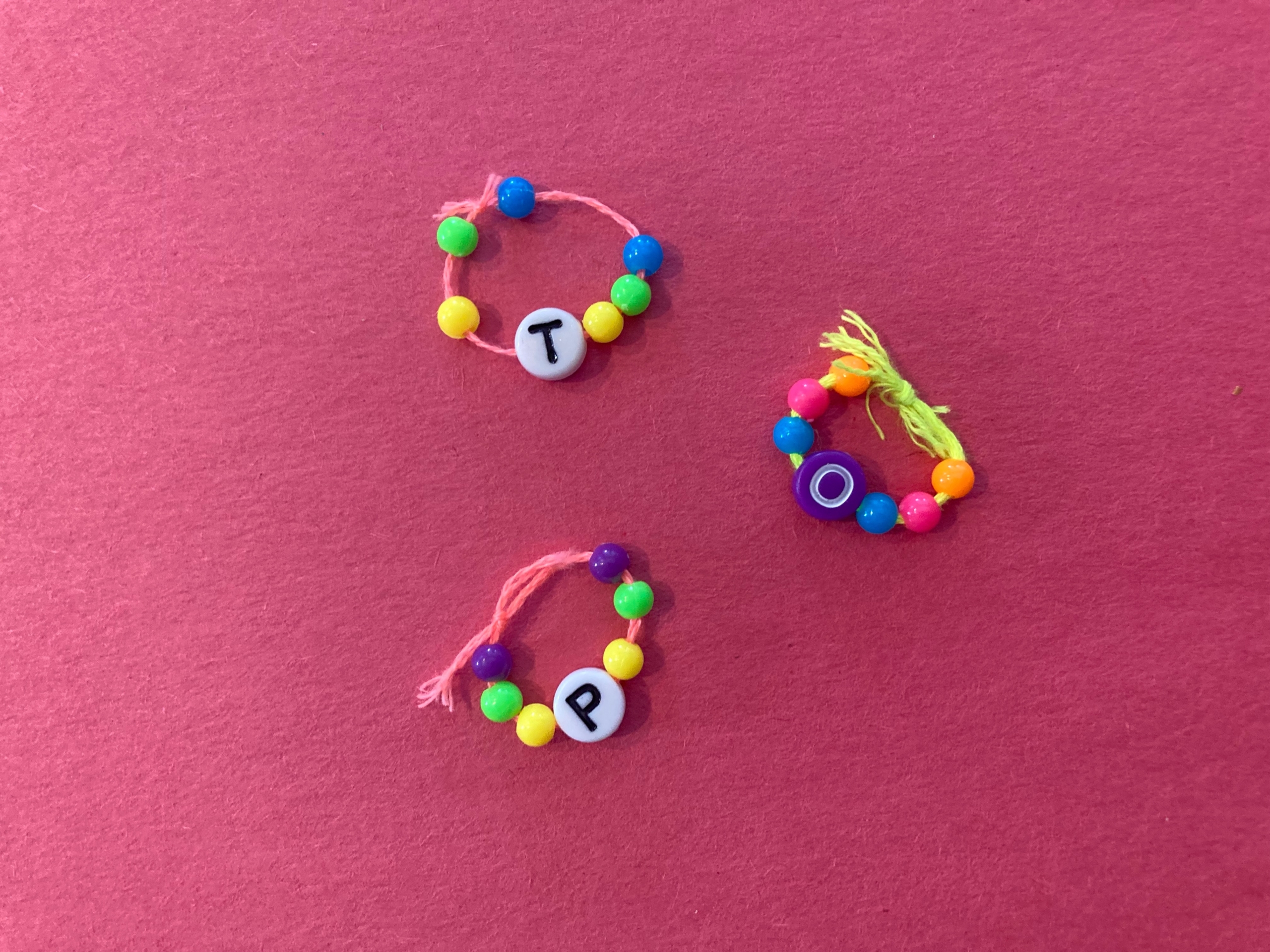
Step 4: Help your child sound out one of your target words and line up the letter rings they need to spell it. Then slide those rings onto their finger and help them read their word! Repeat with as many words as they can find with the letters you’ve used.
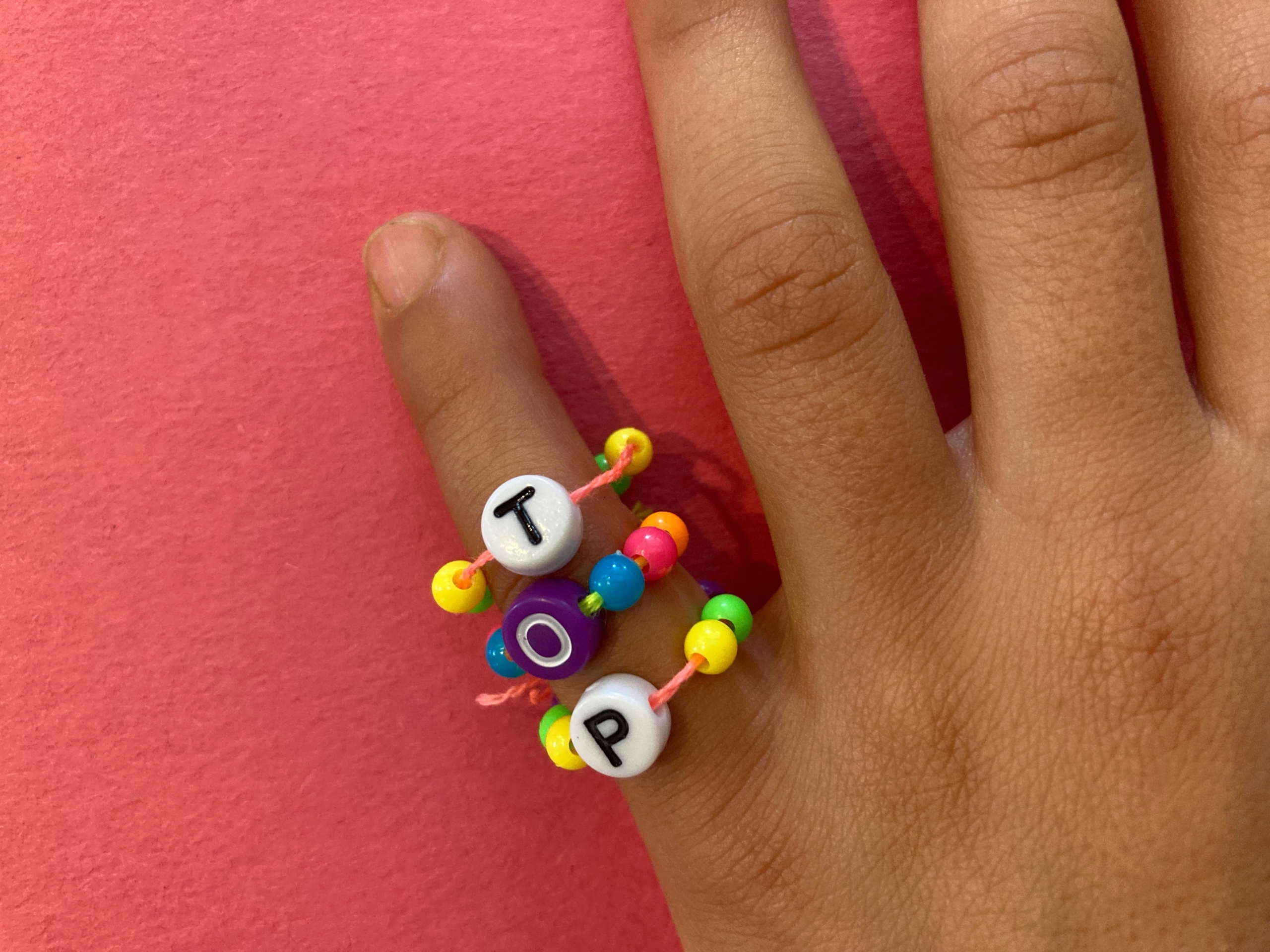
When your child runs out of steam, don’t push them to keep spelling. Kids tire (and get frustrated) quickly, and forcing the matter takes the fun out of it fast. Instead, stash your letter rings to pull out again for brief sessions in the future. They’ll make a great addition to an arsenal of practice-through-play teaching materials. They’re also small enough to keep in your bag for some quick entertainment on the go.
Tip: Start a drawer or shelf with a variety of fun crafts and games that reinforce key skills. Do some of our other literacy crafts with your little one and add them to your stash, as well. Here are some to get you started: a personalized ABC board game, DIY storytelling cards, rhyming Go Fish, literacy Game of War, a conversation hearts spelling game, and a creative sound slider reading tool.
Kids often think of heroes as big, powerful people doing monumental deeds. True heroes, however, come in all shapes and sizes, and not all heroic acts are monumental.
These 10 picture books about animal heroes feature a diverse group of creatures, including dogs, a mule, bees, and even a brave little koala bear. Heroic traits such as kindness, cleverness, and acceptance are highlighted, along with more conventional heroic traits such as bravery and loyalty.
Learning about other animals helps to strengthen children’s sense of wonder, develop empathy for other beings, and cultivate respect for the creatures around them. These 10 picture books about animal heroes also demonstrate a plethora of heroic traits—traits that kids can use to be heroes every day, such as kindness, understanding, and tenacity.
The time is fast approaching: The sound of new zippers rings out and the smell of sharpened pencils fills the air. It’s back to school! Whether it’s your child’s first year in school, it’s their first year back post-pandemic, or they’re an old pro, a new school year can be daunting. But don’t worry! There’s something that can help ease their worries and spark some enthusiasm for their upcoming year—books.
These picture books are special because they cover a wide range of first-day-of-school experiences. In their pages, we meet children just starting out, moving from a new country, expressing their creativity, and celebrating their names (not to mention an adorable cat and one very stressed-out pigeon). Whatever the situation, these picture books about starting school are sure to help guide your child into a less-stressed and happier beginning to the school year.
By Sydney Moninger, COTA/L
Kids love to make a mess. So much so that even the most painstakingly arranged craft can quickly turn into demolition time! Sometimes, the best way to hold their attention is to use the mess productively. This simple and free tactile letter activity lets kids make a controlled mess while learning essential reading and writing skills. The key is using a multisensory approach.
A multisensory activity uses a combination of the five senses: touch, taste, smell, sight, and hearing. Activating multiple senses gets kids more involved in learning and jump-starts the learning process. A classic example of a multisensory learning activity is simply following along on the page while someone reads aloud. Engaging the eyes as they read and the ears when they hear the sound of the spoken word combines these two sensory systems to make them more powerful. It works so well that we use this kind of learning without even realizing it! Multisensory activities are especially fun for kids, and they’re also extra effective: Research shows that using this kind of approach better engages young learners.
As an occupational therapy practitioner, I try to incorporate multisensory learning every chance I get. I’ve found that such projects improve kids’ motivation, attention, and memory of what they learn. This easy tactile letters activity gets kids to use their senses of hearing, touch, and sight all at once. That way, the lessons they learn will really stick.
(Related: For another tactile letter-learning activity, try these Sand Paper Letters!)
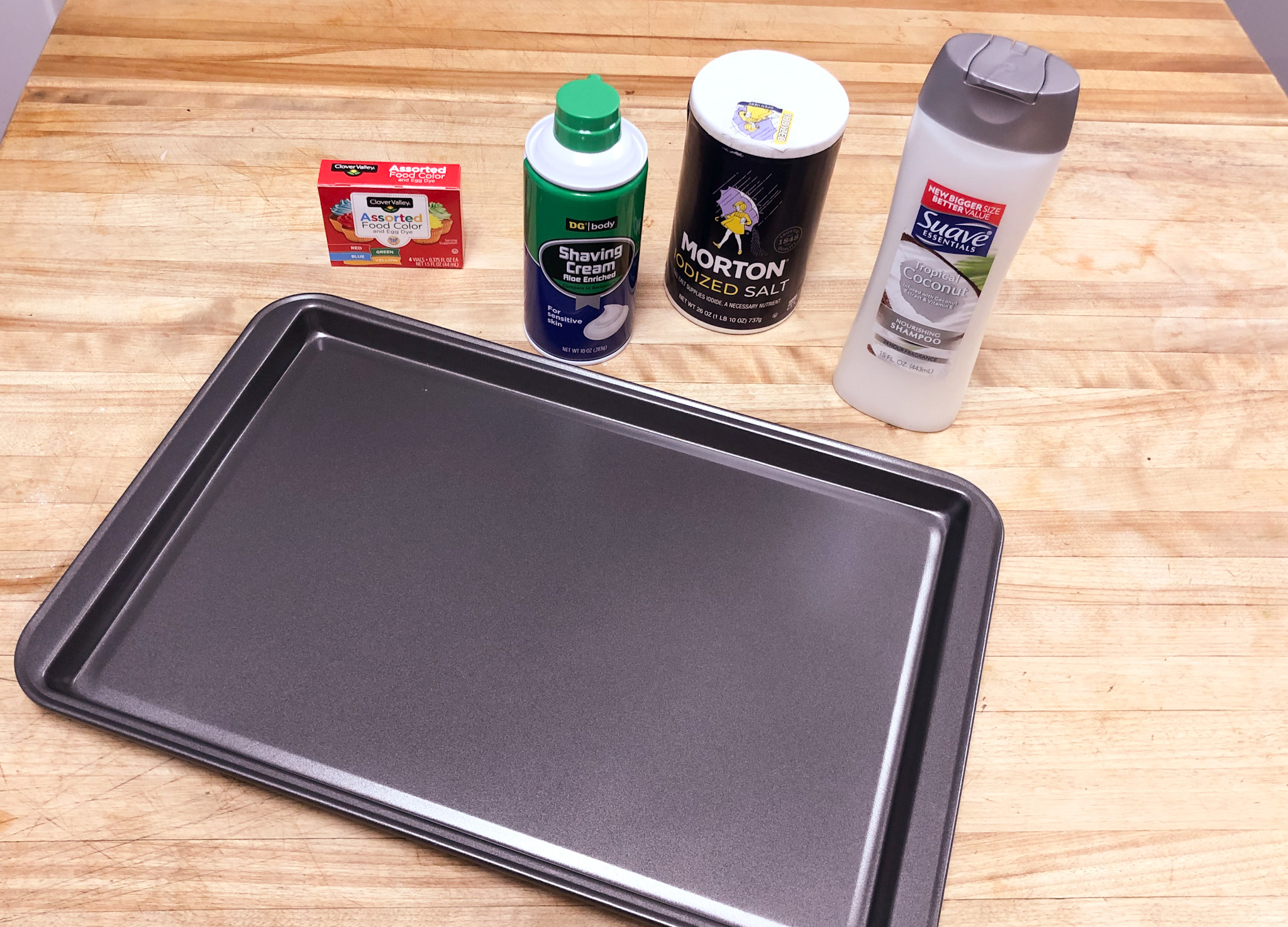
Materials:
- Baking sheet
- Salt
- Shaving cream
- Shampoo
- Food coloring (optional)
Cost: Free if you have these common household items. (Or replace them with other materials you have on hand, from flour to rice to paint to whatever!)
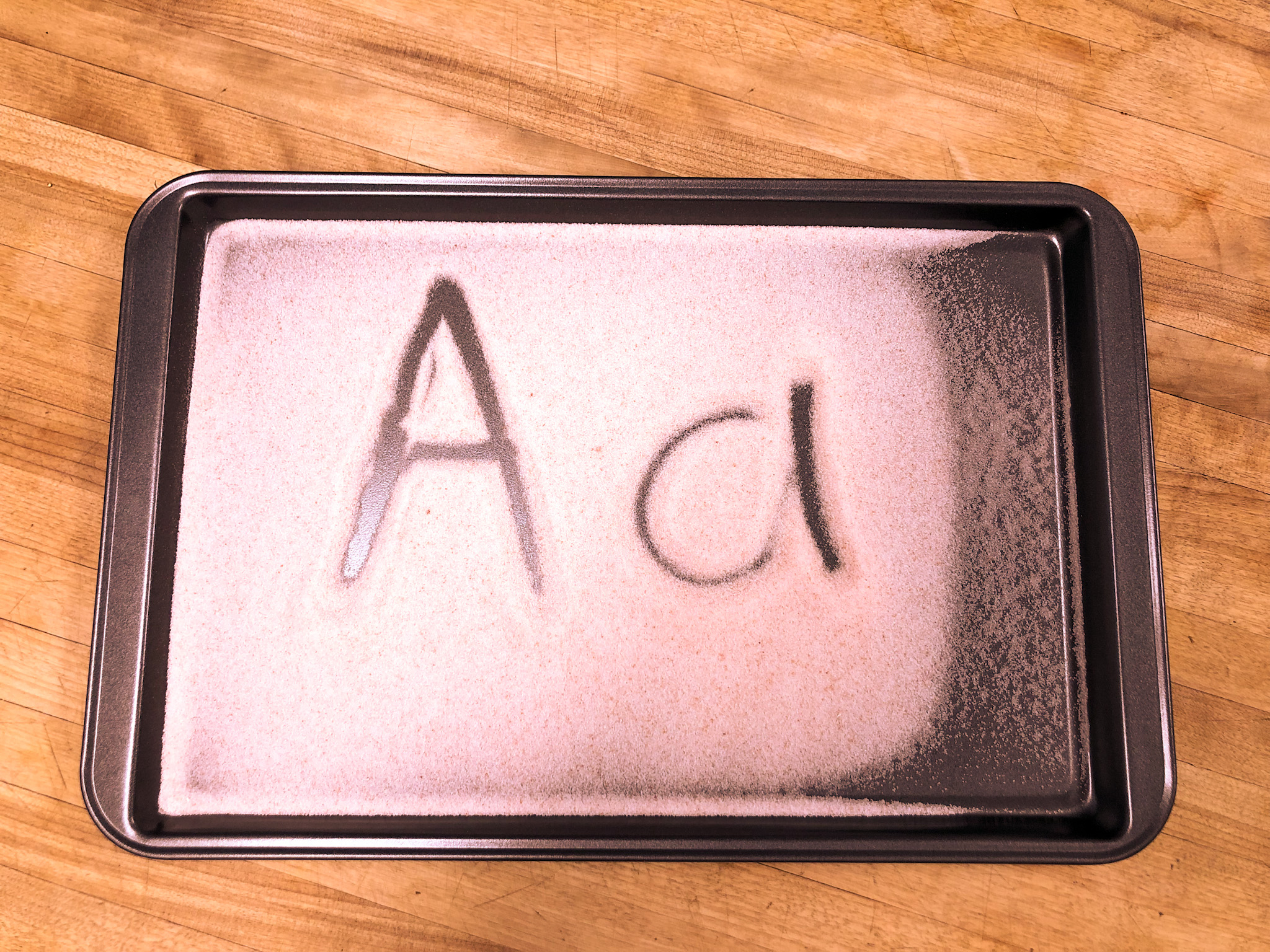
Pour one of your materials onto your baking sheet (this keeps the mess under control). Add food coloring, if desired. Demonstrate writing the letter of your choice on one side of the tray, using your index finger. Say the name of the letter while writing it, then practice the sound that letter makes. Have your child imitate you on the other side of the baking sheet.
Tip: Have them write the letter several times and encourage them to make the sound while they write.
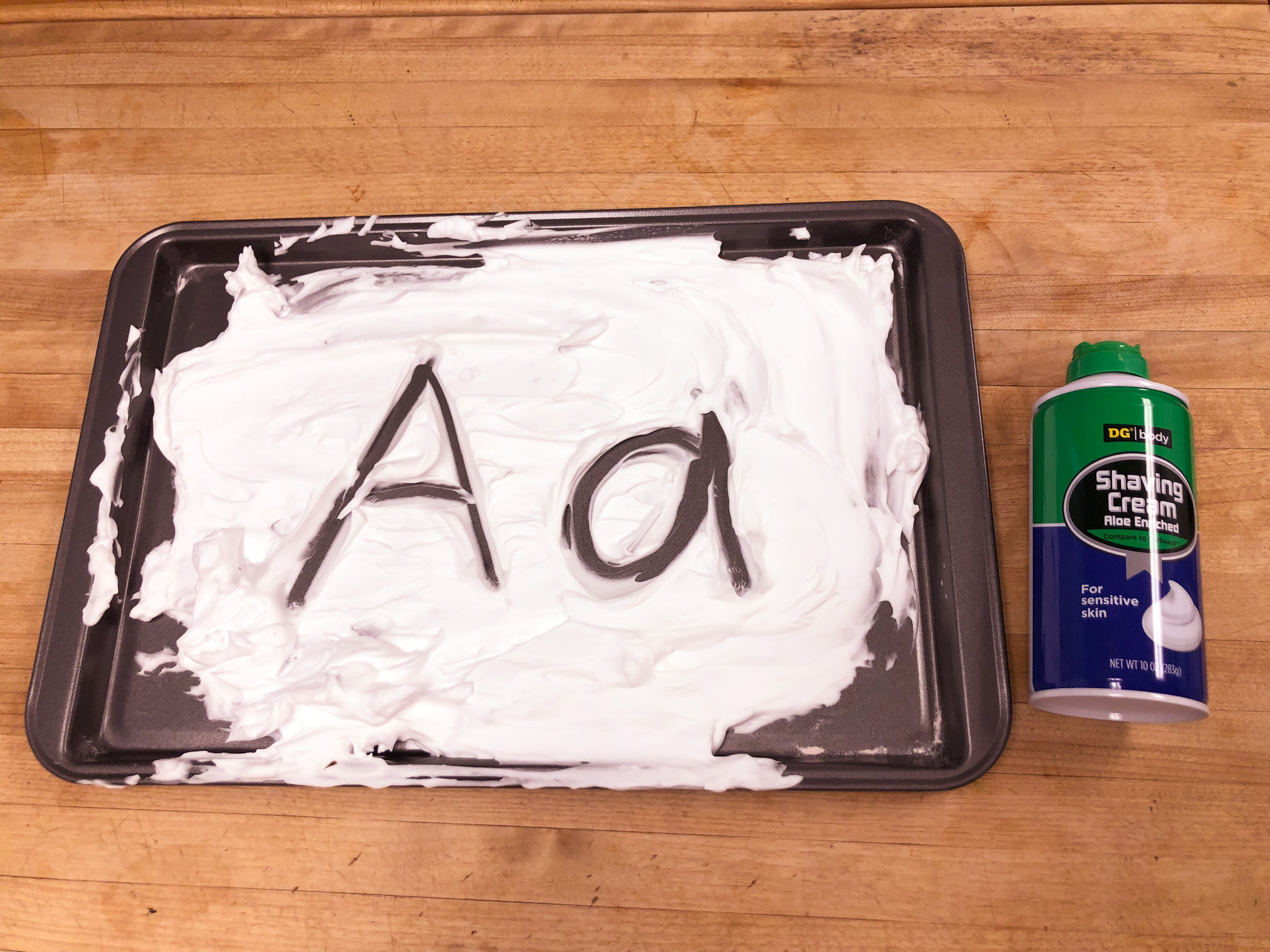
Next, empty the baking sheet and repeat the process with the other materials. (You can also have multiple baking sheets going at once.) The greater variety between the textures, the better! Feel free to add more materials that you find around the house: Finger paint, dried rice, hair gel, flour or cornstarch, and dish soap can all provide unique sensations to write in.
Note: All kids have different preferences for sensory experiences. If your child is very uncomfortable with one particular texture, don’t force it. Instead, let them wipe off their hands whenever they need to. If they are especially nervous, let them use a pencil or paintbrush to write in the medium, so they can ease into the sensation.
For older kids: Move on from writing simple letters to writing whole words. Then take turns practicing spelling or reading.
For an extra boost: Include movement in the activity! For example, have your child sit on a yoga ball or dance while writing. The more senses that you activate, the better—and more fun!
Kids love getting messy in this activity, and we love the opportunity to teach them letter skills.
By Courtney Runn
You have likely spotted one on a neighborhood walk: a small, wooden house perched at the edge of someone’s yard filled with books and a little sign reading, “Take a Book, Leave a Book.”
Since the founding of the nonprofit Little Free Library organization in 2009, these mini book havens have sprung up in more than 100 countries and can now be found on all seven continents.
While simple in concept, these free libraries have long-term impacts on local communities, decreasing book deserts and strengthening neighborhood relationships. Whether you’re looking for fun ways to keep your kids reading over the summer or want to invest in literacy year-round, here are three ways you can use Little Free Libraries to spread the book love in your family and community:
Build your own Little Free Library.
To build your own library, check out the many video tutorials and building tips on the nonprofit’s website. Involve older children by making it a family or neighborhood project, and invite younger children to help pick out books when it comes time to stock your new library.
Reach out to your local school or social organizations like Girl Scout troops to make it a true community effort—and save a few dollars. Once you build yours, register it online to receive an official charter sign and make sure readers can find your library.
If your neighborhood is already home to a Little Free Library or several, consider partnering with an organization to build one in an underserved community or book desert.
Tip: For an environment-friendly (and budget-friendly) library, upcycle items in your home. If you browse the online Little Free Library map, you’ll find countless creative alternatives to display books: repurposed microwaves, cabinets, mini-fridges, wagons, bookcases, etc. The possibilities are endless!
Take your kids on a Little Free Library scavenger hunt.
Whether you’re looking for a local adventure or a kid-friendly activity on vacation, explore the online database of Little Free Libraries to discover new spots near you. Many library owners share the inspiration behind their library and the genre of books available.
Get to know your own town better by making a bucket list of the libraries your family wants to visit. This is a great way to find new books without breaking the bank, make reading fun for kids of all ages, and build a literature-rich household.
When you go visit new libraries, bring a few books along for your kids to leave at each stop. And don’t forget to keep the books you borrow circulating when you’re done with them!
Tip: Make your library quest extra-fun for little ones by creating a map of the libraries you want to visit together. Then go on a walking or driving expedition to find them.
Support the Read in Color Initiative.
Read in Color is one of the Little Free Library nonprofit’s latest initiatives to support representation in children’s books. According to data released by the Cooperative Children’s Book Center, only 30 percent of children’s books in 2020 centered non-white characters—a significant underrepresentation compared to the actual U.S. population, which is estimated at closer to 40 percent non-white.
In 2020, Little Free Libraries launched the program in the Twin Cities by building 20 new libraries in underserved neighborhoods, stocked with books featuring characters from underrepresented groups. To support this effort, you can sign the pledge online and receive stickers and bookmarks for your own library.
If you have a Little Free Library, stock it with books from a wide variety of authors to ensure everyone who stops by your library can see themselves in the stories. You can also drop off books to little libraries in your area to increase representation, as well as looking for libraries dedicated to diversity on the online library map.
Tip: When stocking your own library or donating to others, shop for children’s books at Bookshop.org to support independent bookstores. If you’re on a tighter budget, you can also find great reads at garage sales or discounted bookstores.
By Chrysta Naron
“Plain paper is boring. I don’t know what to draw!” Hayes whined. My little friend wanted a coloring book—a Paw Patrol coloring book, to be exact. I understood his point of view; coloring books can be a lot of fun. But here’s the thing about standard coloring books. They don’t allow children to create their own ideas. And children naturally are wonderfully and wildly creative, even when they doubt themselves. So I devised a plan.
“Let’s make a surprise book!” I said to Hayes. He was intrigued. Here’s how we did it: Working together, Hayes and I created an entire coloring book of our own, plus a story to go with it. Through this process, Hayes practiced his pencil grip, writing, print knowledge, and storytelling, without even noticing it. Plus, best of all, his imagination was unleashed!
If this sounds like a winning way to spend a day with your child, let me show you how to create your own coloring book, below.
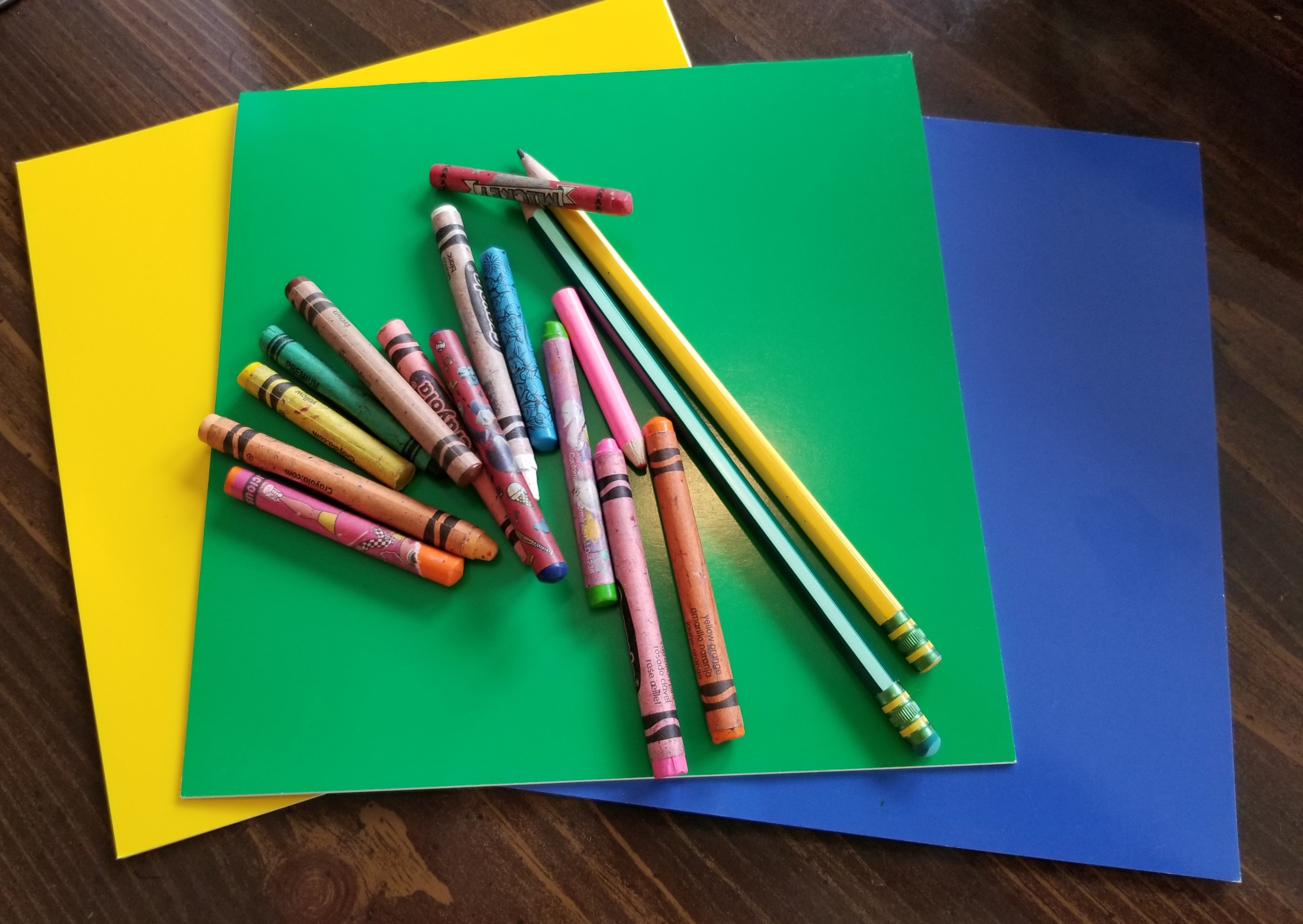
Materials:
- Journal with blank pages
- Crayons, markers, or pencils
Cost: $5
Step 1: On the first page of the book, draw a simple shape, such as a line, a curve, or a square.
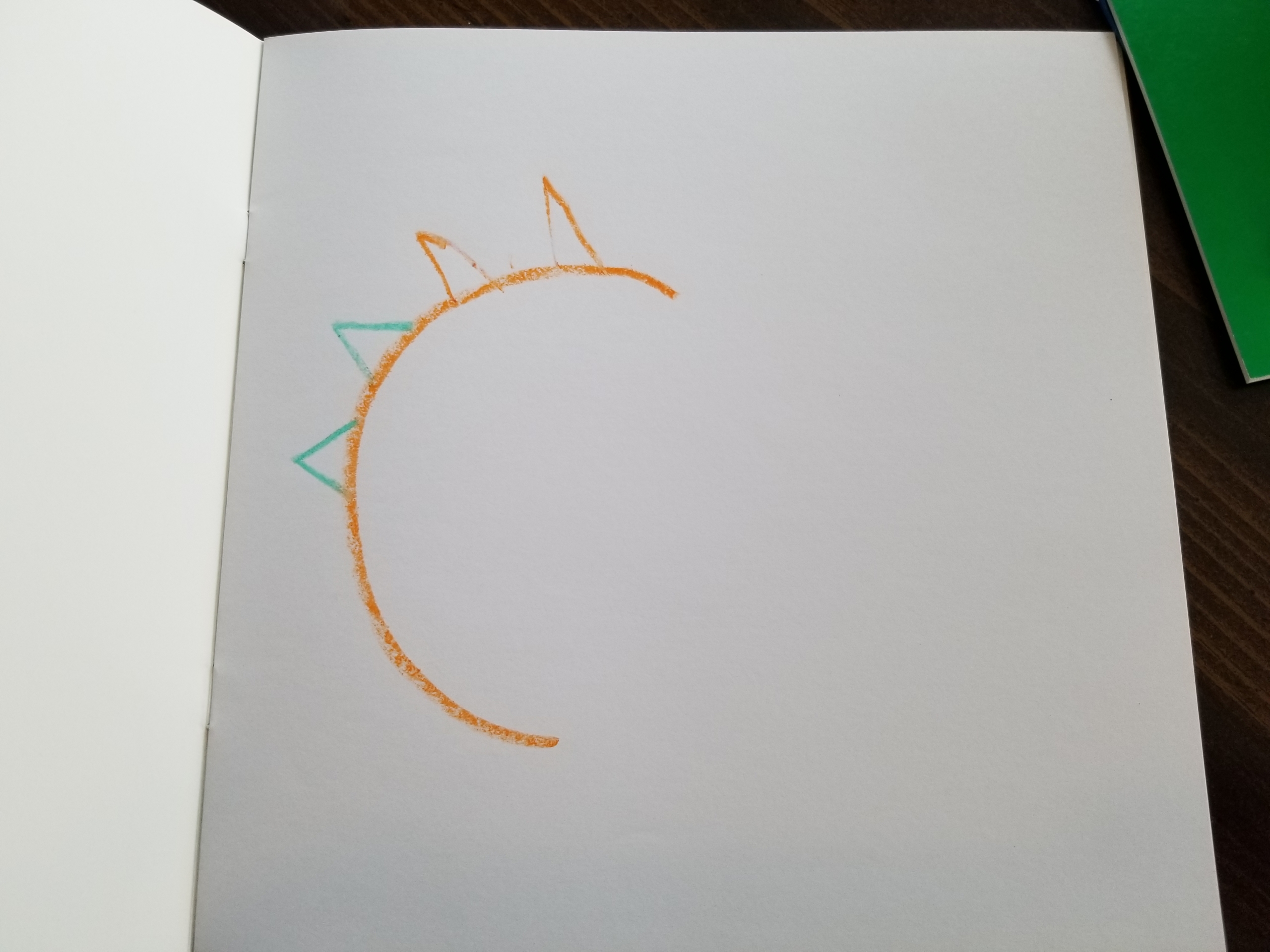
Step 2: Pass the book to your child and ask them to contribute some lines or shapes to the page. Don’t color them in just yet!
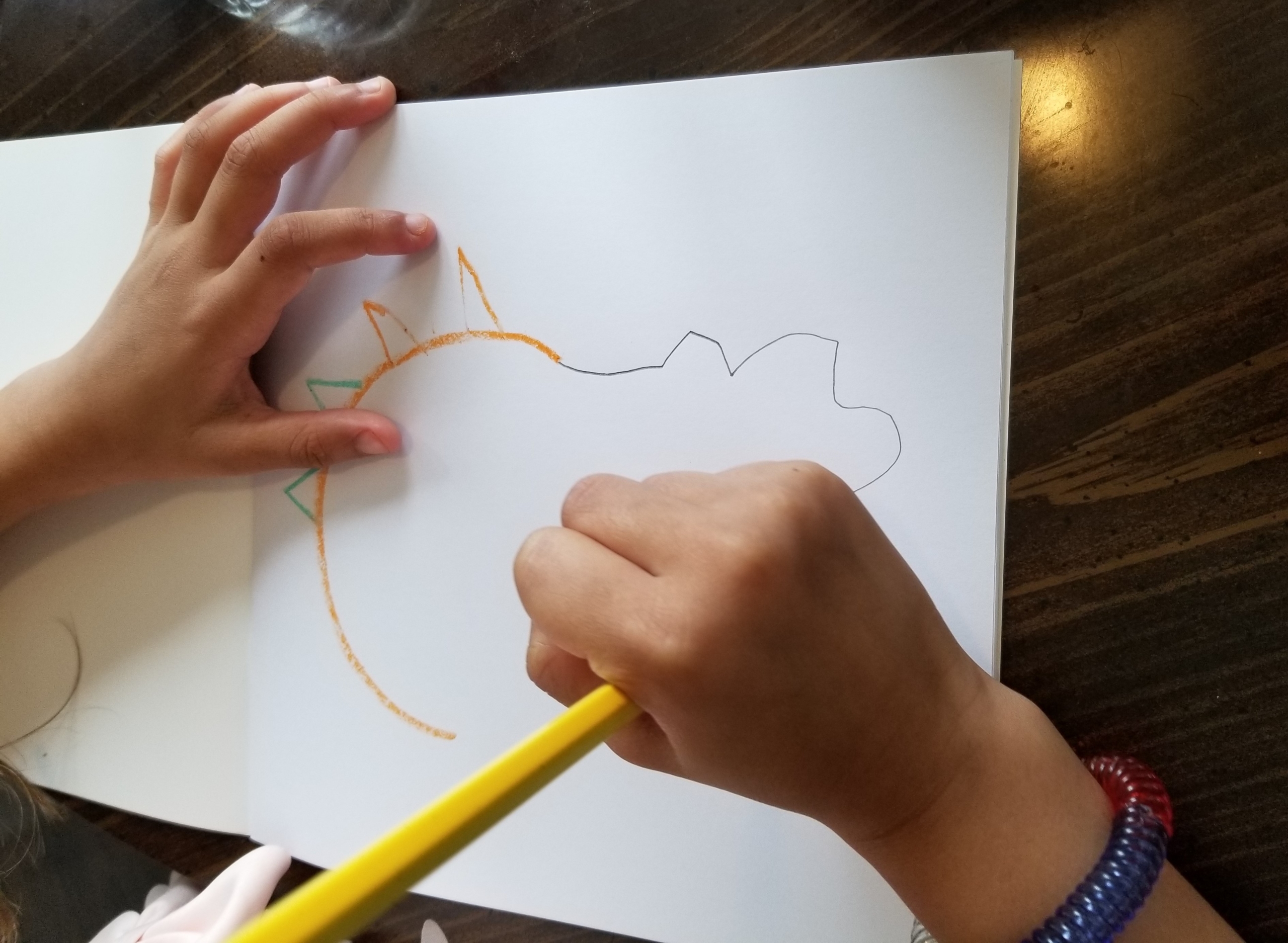
Step 3: After your child contributes their portion, pass the book back and forth until you both feel your picture is done!
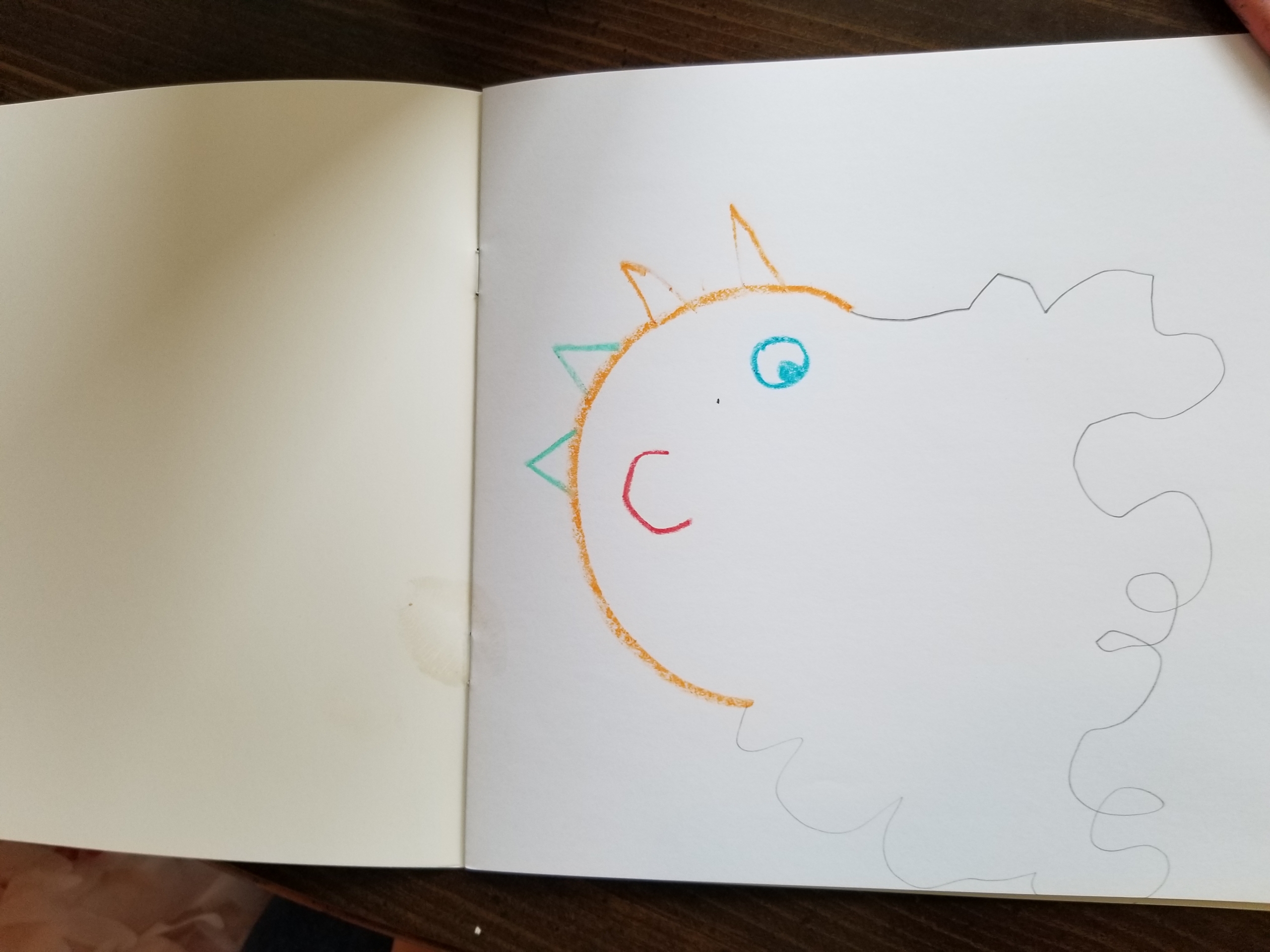
Step 4: Ask your child to title the picture or explain what’s going on in it. Write down the description on the page for younger children or less confident writers. For kids who are ready, let them attempt to write it themselves.
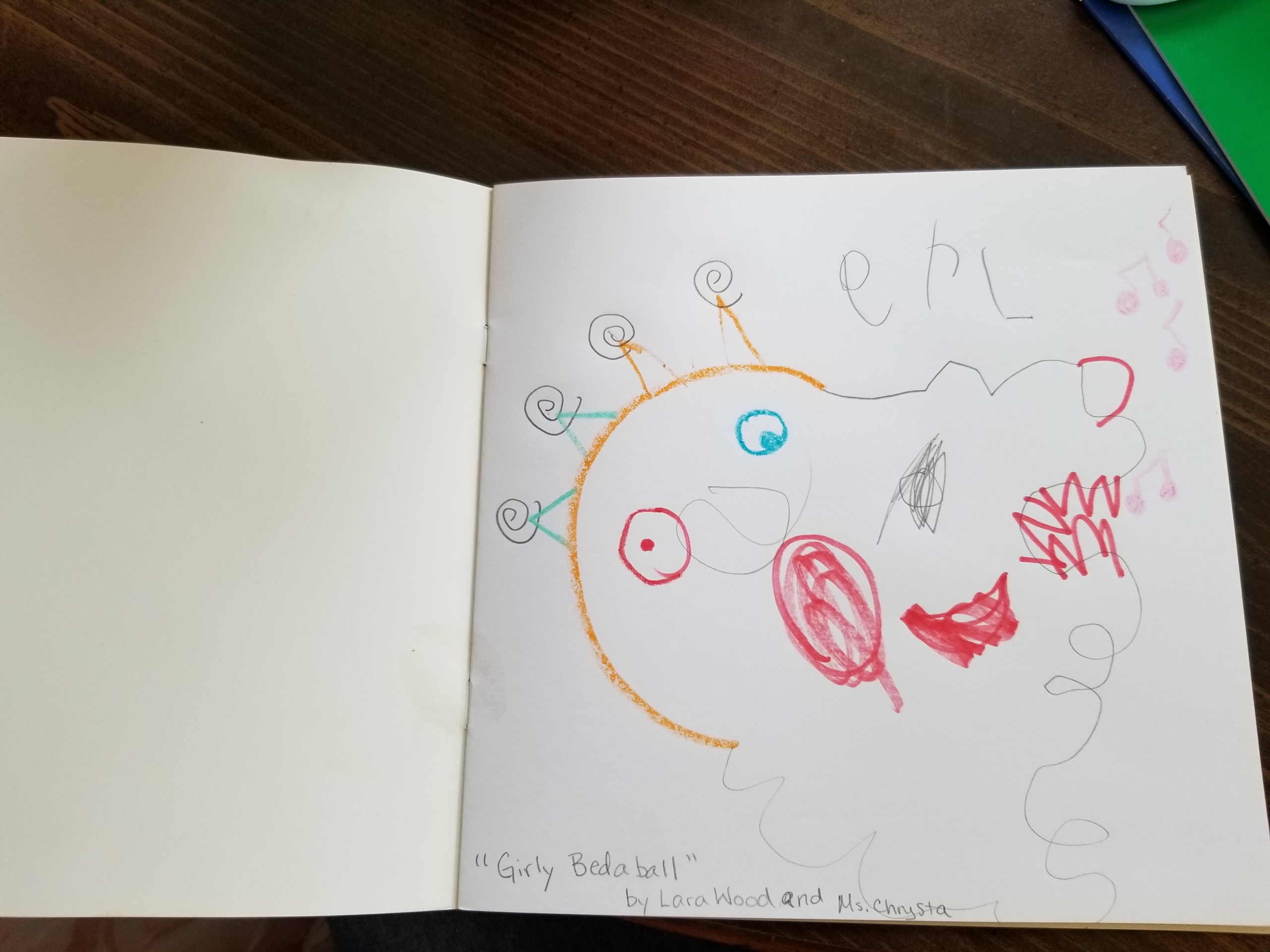
Step 5: Turn to a fresh blank page and start again! This time, let them go first. Soon, you’ll have a book filled with coloring pages.
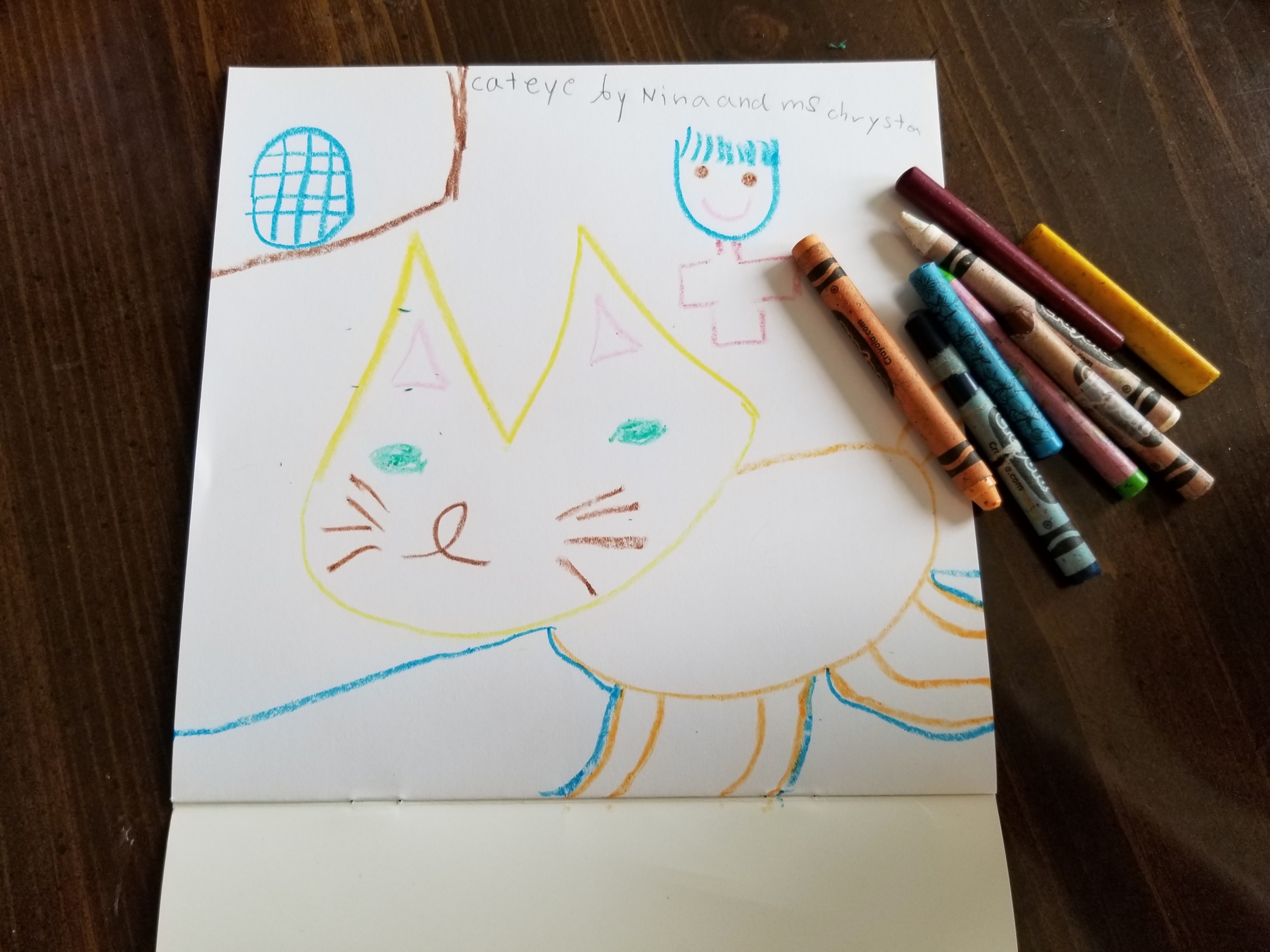
When you’re all done, you can take the book and review what you’ve made and written together. This helps to reinforce print knowledge, like learning that sentences go from left to right and that punctuation is found at the end of sentences. It also allows children to weave together a narrative, an important part of storytelling. It’s fun for them to recognize that they were able to create their own story, even when they at first had no idea where it was going to begin or how it was going to end!
After you’ve finished enjoying your great collaborative masterpiece, hand the book over and let your child color in the pages. While they color, you can revisit the story again. Do the pictures mean the same thing to them as they did the first time? Has the story changed? Do they want to add more to any pictures as they color them in? There are so many fantastic places this can go. And in the end, your child will learn more, express themselves more, and have a stronger memory with you from this homemade coloring book than from any coloring book you could ever buy.
By giving your child a slight nudge, with no desired outcome, you’ll open a door for them to explore their imagination and all that it has to offer their learning experience. What ideas will unfurl as you sit with one another and a blank piece of paper? The possibilities are endless.
Did you and your child create your own coloring book? We’d love to see it! Share pictures on social media and tag Maya Smart.


